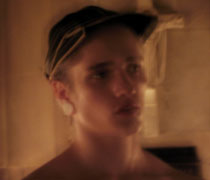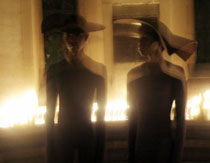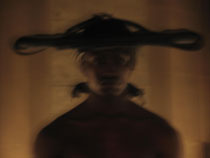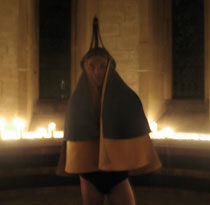October 15, 2013
October 18, 2013
March 26, 2013
October 26, 2011
October 24, 2011
March 10, 2011
December 3, 2010
January 18, 2010
January 05, 2010
May 11, 2009
March 01, 2009
Febuary 14, 2009
December 30, 2008
December 26, 2008
September 29, 2008
June 25, 2008
March 01, 2008
january 05, 2008
JULY 11, 2007
JULY 11, 2007
June 18, 2007
June 18, 2007
Febuary 16, 2007
Febuary 08, 2007
December 08, 2006
October 18, 2006
June 28, 2006
June 27, 2006
November 27, 2005
|
|
SEPTEMBER 29, 2008
Nasir Mazhar - autumn/winter 2009/10
By Michele Occelli
NASIR MAZHAR autumn/winter - Descending into the underworld, ascending unto the celestial spheres.
Since time begun, mysteries are moments when symbols congeal, when sacred and profane are woven into novel meanings. Inside the chapel of Saint Barnabas the flashes announce the mystery of Nasir Mazhar's Autumn/Winter collection. The 19th century Romanesque chapel chosen to host this collection is itself a location unlocated, its style bringing us back to Arthurian romance yet pushing us forward into the mist of the already unintendedly post-modern.
We enter. The eyes wonder across the defined simplicity of a symmetrical plan, the round arches, the sturdy piers, the decorative arcades. The architecture is textured yet consciously silent, an ornate background frame. Suspended as in time so in space is a floating landscape of leathers and marbles, of gold planetariums and naked torsos. As if photograms, as if the lingering records of a sequential high-fashion strip tease, Nasir's headpieces interrupt the candle-lit softness of the space with the density of their presence. It is both cinematic and archetypal; a god/dess passed by his/her chambers and relieved him/herself of his/her embellishments, resting them on the inanimate mannequins. The designs are themselves laden with a profound alchemical a-temporality. White cast masks, which seem conjured out of Adrian's villa; a girl sits on the altar stairs wearing a golden spherical mechanism worthy of John Dee's study. On the left side, in the small aisle stands what looks like a Florentine battle headdress followed, in the one adjacent, by two violently modern geometrical leather pieces which, after a second look, subtly remind us of the flying machine drawings of Leonardo. On the opposite side we have the most visually immediate design of the whole collection, a dark leather cap that can be worn like a traditional baseball headgear. The tour finishes with a sombre round shaped My-Fair-lady companion to it.
Through a complex choreography of undressing, Inanna-Ishtar, the goddess of Love and War, is relieved of her sacred robes as she ventures into the great place below'. At each of the seven gates of hell she will give up one of her adornments. This primordial descent magnifies how that which covers the body can be invested with the complex symbolism, which lies in the tension between the material and immaterial, the concrete and the abstract, the day and the night. Nasir's designs tread upon this line of tension. They convey, as objects, our very relation to the world. They become embodiments of faculties given up in the passage from day to night, from material to conceptual. Faculties re-acquired as they are 'brought back within' in the mirror movement from conceptual back to material. It is the coexistence of diametrically distant qualities - antique materials pushed into radically novel shapes, and classic design de-localised through strongly unusual materials - that renders the effect of this collection so intensely sensual. Rejecting the overly reflective nature of much contemporary design, the predation of abstraction opens the senses; Nasir's mythology embodies the quality of movement, of ascension. As if suspended in an act of purification, which both retains the roughness of its primeval origin while already thrusting itself towards its celestial hue, the work of this young designer seems to affect a cathartic rejection of the dead ends of contemporary design. A re-appropriation of life through form, of its mystery through the ambiguity and non-resolution of its inherently incomprehensible tensions.
In the chapel, which is both object and performance, and tension between the two, Ernesto Tomasini's voice wraps the ear with a disorienting lineage of baroque and renaissance pieces whose cadenzas have been carefully pushed towards blues and avant-garde inflections. Beginning with a church-like simplicity, the Sicilian counter-tenor moved slowly towards a full blast operatic sound. Arias from Handel and Gluck, Renaissance songs and some original compositions (Stoo Kuinnutu among others) were revealed anew with a mix of experimental homage inspired by the voices of great Artistes such as Yma Sumac and Eartha Kitt. Wearing what looks like the operatic costume of a crimsoned roman consul the artiste extraordinaire sunk the collection into the iconic grace of a Pasolini set, where the hue of classicism and the smack of its radical subversion coexist in an act of fleshy thundering creativity.
Michele Occelli.
Links
MICHELE OCCELLI
SHOW PICTURES
|
|





|
|
|

